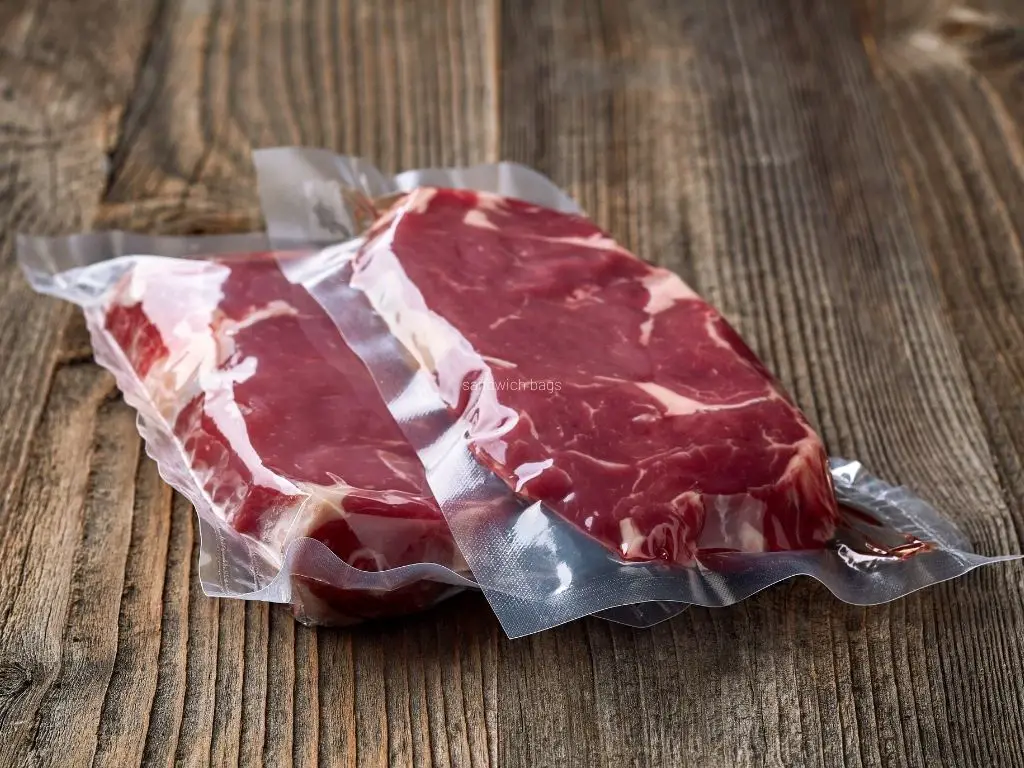Sous vide cooking has become an increasingly popular technique for cooking meat to perfect doneness and tenderness. The process of vacuum sealing meat and cooking it in a precisely temperature-controlled water bath allows you to achieve edge-to-edge even cooking and excellent moisture retention.
Salting meat before sous vide is a key step that can greatly enhance the flavor and texture of the final dish. Understanding the science behind pre-salting and how to do it properly will help you get the most out of sous vide cooking.

Sous Vide Products I Use Every Day
As an Amazon affiliate, I earn from qualifying purchases.
Last update on 2025-03-03 / Affiliate links / Images from Amazon Product Advertising API
The Science Behind Salting Meat Before Sous Vide
Salt interacts with meat on a molecular level, dissolving some of the muscle fibers and proteins. This allows the salt to penetrate deeply into the meat rather than just seasoning the exterior.
When meat is pre-salted and then vacuum sealed, the salt penetrates the meat while it is sealed in the bag. The salt helps to dissolve some of the proteins, allowing them to cross-link and retain moisture better during cooking.
Pre-salting also seasons the meat all the way through, not just the outer surface. Salty flavors will spread evenly throughout each bite when you pre-salt before sous vide.
Pros and Cons of Salting Meat Before Sous Vide
Salting meat before you start sous vide cooking has a number of advantages:
- Deeply seasons the meat throughout
- Dissolves muscle fibers for more tender meat
- Allows proteins to retain more moisture
- Gives meat a juicier texture
- Provides well-balanced salty flavor in each bite
However, there are a couple potential downsides to keep in mind:
- Can draw out too much moisture if over-salted
- May need to adjust seasoning after cooking if under-salted
As long as you use the proper amount of salt, the pros generally outweigh the cons when pre-salting meat for sous vide.
How to Properly Salt Meat for Sous Vide Cooking
When pre-salting meat for sous vide, there are a few guidelines to follow:
- Use kosher or sea salt – about 1/2 to 1 teaspoon per pound of meat.
- Evenly sprinkle salt all over the meat before sealing.
- Allow salted meat to rest sealed in fridge for at least an hour, up to overnight.
- Rinse off excess salt and pat dry before cooking if curing over 8 hours.
- Add any other seasonings like herbs and pepper before sealing.
- Cook using your desired time and temp based on thickness.
- Check for seasoning and add more salt/pepper as needed after cooking.
The exact amount of salt can vary based on personal taste and the particular cut of meat. Beef or lamb generally needs more salt than pork or chicken.
Does the Type of Salt Matter in Sous Vide Cooking?
You can use regular table salt when salting meat for sous vide, but kosher salt or sea salt are better options. The coarser grains of kosher/sea salt dissolve slower, allowing the salt to penetrate the meat more thoroughly before the meat cooks.
Table salt often uses anti-caking agents that can cause a “soapy” flavor. The purity and flavor of kosher or sea salt gives the best results. However, if table salt is all you have, it will still work.
Sea salt will provide a touch of mineral flavor, while kosher salt has a clean salinity that lets the meat shine. Either enhances the flavor of meat without overpowering it.
When Should You Not Salt Meat Before Sous Vide?
While pre-salting does wonders for most meats, there are a couple cases where you may want to refrain:
- Very delicate or lean cuts like filet mignon. Salting too early can start to cure the meat.
- Thin cuts or fish filets under 1-inch thick. These cook so quickly the salt doesn’t have time to penetrate.
- Meat that will cook a very short time. The salt doesn’t have time to blend flavors.
For these situations, you can add a light sprinkling of salt just before sealing the meat or fish. The brief contact time will provide enough seasoning.
What Other Seasonings Can Be Used in Sous Vide Cooking?
Salt is essential for flavoring meat, but other seasonings can also be added before or after sous vide cooking:
- Fresh or dried herbs and spices – thyme, rosemary, garlic, etc.
- Whole peppercorns and pepper flakes for punchy heat.
- Umami flavors like soy sauce, Worcestershire, or miso paste.
- Marinades and rubs with acidic ingredients to tenderize.
- Finishing oils and butters provide richness after cooking.
Layer flavors by seasoning at various stages – before sealing, in the bag, and after cooking. Allowing seasonings to cook with the meat infuses more flavor.
Perfecting Your Sous Vide Technique
Mastering the simple step of pre-salting your meat is one of the keys to perfecting your overall sous vide cooking technique. Combine it with the right timing, temperature, and seasoning for phenomenal results.
Remember, sous vide enables edge-to-edge even cooking from the inside-out. Salting before sealing ensures deep flavor in every bite. As you dial in the amount of salt you prefer, you’ll be enjoying juicy, well-seasoned meat and elevating your sous vide game.


![IMPRESA [10 Pack] Sous Vide Magnet Weights for Keeping Bags Submerged – Sous Vide Accessories to Stop Floating Bags & Undercooking – Weighted Magnets for Containers](https://m.media-amazon.com/images/I/41zHpl8G2lL._SL160_.jpg)

